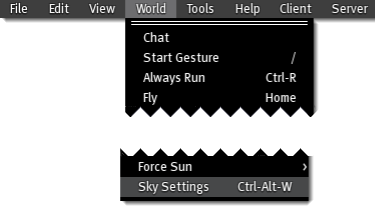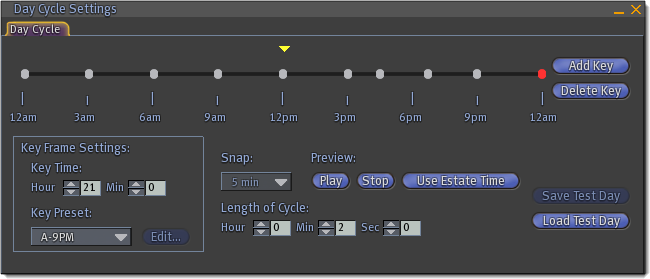Difference between revisions of "History/WindLight"
| Line 86: | Line 86: | ||
[[Image:kb_sky_day_cycle_menu.png]] | [[Image:kb_sky_day_cycle_menu.png]] | ||
You can bring up the Day Cycle Editor by pressing the '''Day Cycle Editor '''button on the Region/Estate Sky Settings window.The Day Cycle Editor gives you control over the sky during Second Life's day/night cycle. This is accomplished by setting keyframes (set using the Region/Estate Sky Settings window) for different hours of the day. Second | You can bring up the Day Cycle Editor by pressing the '''Day Cycle Editor''' button on the Region/Estate Sky Settings window. The Day Cycle Editor gives you control over the sky during Second Life's day/night cycle. This is accomplished by setting keyframes (set using the Region/Estate Sky Settings window) for different hours of the day. Second Life will interpolate the difference between keyframes, giving you smooth transitions as the day progresses. | ||
Revision as of 11:11, 29 May 2007
The Sky Menu gives you a fine degree of control over Second Life's sky and atmosphere. Imagine a strange alien planet with a purple sky, or a smoggy, overcast city! This guide will help you to understand the many controls at your disposal, and set you on the path to becoming a weather-controlling mad scientist.
This article describes what each of the individual settings in the Sky Settings menu is responsible for. However, many of the settings described are closely interrelated, and may affect one another in subtle ways. The best way to truly become a sky master is to play with these settings and see how each one affects your sky. To help you get started, here are the basic facts:
| Note: The WindLight sky is currently a feature of the First Look viewer. By definition, the features and controls in this article are subject to change and improvement at any time! |
Opening Sky Settings
To begin editing the sky and atmosphere, you must first open the Sky Settings menu. You can do this by selecting World > Sky Settings or by pressing Ctrl+Alt+W.
Region/Estate Sky Settings
The Region/Estate Sky Settings window is where you will be making visual changes to sky and atmosphere "keyframes" (see the Day Cycle Editor section for more about keyframes). It contains three tabs, each with a number of sliders for manipulating the sky's appearance:
The Atmosphere Tab
This tab controls elements of the atmosphere itself:
Blue Horizon: Use the Red/Green/Blue (RGB) sliders to adjust the color of the sky. You can use the Intensity (I) slider to move all three RGB sliders in unison. In meteorological terms, this setting affects "atmospheric scattering", which is the scientific answer to the age-old question, "Why is the sky blue?"
Blue Density: Blue Density affects the overall color saturation of your sky. If you move the Intensity (I) slider to the right, your colors will become brighter and more vibrant. If you move it all the way to the left, your colors will become duller, eventually fading to black and white. If you'd like to fine-tune your sky's color balance, you can control individual elements of saturation by using the Red/Green/Blue (RGB) sliders.
Haze Horizon: This setting affects the height of haze on the horizon. At higher settings, the haze will reach up into the sky and obscure the actual horizon. Haze on the horizon can help to accentuate the sun, and create a dusty, smoggy, or humid effect. This setting will not work if Haze Density is set to zero.
Haze Density: Haze density affects the amount of haze you can see in the atmosphere. At lower settings, this can make for some great outdoor views in dusty or tropical environments, and at higher levels it can create a thick, vision-obscuring fog. If you set Haze Density to zero, the Haze Horizon setting will have no effect.
Density Multiplier: The Density Multiplier can be used to affect the overall atmospheric density. At lower settings, it creates a feeling of "thin air", and at higher settings, it creates a very heavy, smoggy effect.
Distance Multiplier: This setting affects your perceived distance within the atmosphere. To make everything look hazy and distant, move the slider to the right. If you want to completely remove the Sky Settings' effects from terrain and objects, set the slider to zero.
Max Altitude: Adjusts the altitude calculations Second Life makes when it is computing atmospheric lighting. At later times of day, it can be useful for calculating how "deep" a sunset appears, while at noon it can be used to achieve proper brightness values.
The Lighting Tab
This tab controls the sun, ambient lighting, and the stars:
Sunlight Color: This setting affects the color of your sun, and the sunlight it produces. Keep in mind that the color of your sun's rays will affect the color of your sky! To change Sunlight Color, use the Red/Green/Blue (RGB) sliders, or use the Intensity (I) slider to move all three RGB sliders at once.
Time of Day: The Time of Day setting affects the vertical position of the sun, from sunrise (0.0) to noon (0.5) to sunset (1.0).
East Angle: The East Angle affects the horizontal position of the sun, and is similar to azimuth. At settings of 0.0 and 1.0, the sun will rise in the East and set in the West. The settings in between define the entire circle of the horizon; at a setting of 0.5, the sun will rise in the West and set in the East, at a setting of 0.25 the sun will rise in the South and set in the North, etc.
Sun Glow: There are two settings under Sun Glow: Size defines the size of the sun, and Focus adjusts how much the sun blurs over the sky. At very high settings, Focus can cause the sun to completely wash out a portion of the sky with brilliant light, and at zero, it will cause the sun (but not the light it casts) to disappear from the sky.
Ambient: This controls the color and intensity of ambient light in the atmosphere. This is used for simulating the way the sun lights up the atmosphere and the world; you could theoretically have a very bright sun, and a relatively dark world (think of a sunset!), but if you wanted to simulate mid-day illumination with the sun low in the sky, you would need to increase the intensity of the ambient light.
Scene Gamma: This control functions similarly to the Gamma setting in your Adv. Graphics preferences. It adjusts your screen's distribution of light and dark output. Lower settings will cause everything to appear dim, while higher settings may make the scene look gray and "washed out".
Star Brightness: Star Brightness defines how visible the stars are in the sky. If play with this slider while the sun is up, you can see stars in the middle of the day!
The Clouds Tab
This tab gives you control over the clouds in the sky:
Cloud Color: This affects the color of your clouds, if you have any. Use the individual Red/Green/Blue sliders to change the color, or the Intensity (I) slider to drag all three at once.
Cloud XY/Density: Use the X and Y sliders to change the horizontal position of all clouds in the sky. The D slider affects the overall density of the individual clouds; at low settings you will see thin, wispy clouds, and at higher settings you will see thicker, more solid clouds.
Cloud Coverage: As the name implies, this control sets the amount of cloud coverage. At zero, there isn't a cloud in the sky, but at higher settings, you can get a completely overcast effect.
Cloud Scale: This setting affects the perceived altitude of the clouds... if you slide the control to the right, it will make the clouds appear to be higher in the sky.
Cloud Detail (XY/Density): These settings affect the detailed image layer above your normal clouds. The X and Y sliders shift its horizontal position, and the D slider controls how puffy and/or fractured your clouds look.
Cloud Scroll X and Cloud Scroll Y: These sliders affect the direction and speed at which the clouds float in the sky. You may also check the Lock checkbox to prevent clouds from moving on the selected axis.
The Day Cycle Editor:
You can bring up the Day Cycle Editor by pressing the Day Cycle Editor button on the Region/Estate Sky Settings window. The Day Cycle Editor gives you control over the sky during Second Life's day/night cycle. This is accomplished by setting keyframes (set using the Region/Estate Sky Settings window) for different hours of the day. Second Life will interpolate the difference between keyframes, giving you smooth transitions as the day progresses.




